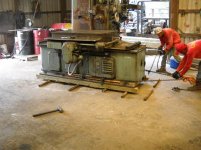cwtoyota
Cast Iron
- Joined
- Feb 11, 2010
- Location
- Washington State
I am getting ready to move a VMC into my "new" shop.
I am interested in hearing some input on how much load is too much for my concrete slab.
The details are as follows:
VMC: Kuraki KV-700 VMC (weight is estimated at 12200 lbs)
Forklift: Rental machine 20K - 22K capacity with pneumatic tires. (weight estimated at 22000 Front / 18000 Rear [unloaded])
Concrete: 4000 PSI mix with fiber poured 6" thick over 2"(R-10) Foamular XPS 250 foam. (just over 2 year old slab, so it's had time to cure).
Re-mesh is #9 x 6" and is about 1.5" - 2" up from the bottom of the slab covering the entire area.
Rebar is #4 bar (1/2") on a 18" x 30" grid where the machines will sit, but I have to drive across the middle of the shop that has #4 re-bar on a weaker 76" x 60" grid.
This is a monolithic slab with turned-down footings (no foam under footings). I reinforced the area in front of the 12 x 14 door with an extra 38" x 22" grid of #4 bar extending 40" into the field to prevent that transition across footing to field from breaking.
The reason for the XPS foam insulation is that this is a radiant heated slab with a grid of 1/2" pex on 12" centers.
I'm not asking for engineering (in spite of all the detail) just your experiences with how worried I should be about this.
Is driving a heavy forklift with a 12000 lbs load into my building something I should even be considering?
This is my first thread here, although I've been reading things on the board for years. Hopefully my post adheres to the rules.
Thanks in advance for any input you guys can give!
I am interested in hearing some input on how much load is too much for my concrete slab.
The details are as follows:
VMC: Kuraki KV-700 VMC (weight is estimated at 12200 lbs)
Forklift: Rental machine 20K - 22K capacity with pneumatic tires. (weight estimated at 22000 Front / 18000 Rear [unloaded])
Concrete: 4000 PSI mix with fiber poured 6" thick over 2"(R-10) Foamular XPS 250 foam. (just over 2 year old slab, so it's had time to cure).
Re-mesh is #9 x 6" and is about 1.5" - 2" up from the bottom of the slab covering the entire area.
Rebar is #4 bar (1/2") on a 18" x 30" grid where the machines will sit, but I have to drive across the middle of the shop that has #4 re-bar on a weaker 76" x 60" grid.
This is a monolithic slab with turned-down footings (no foam under footings). I reinforced the area in front of the 12 x 14 door with an extra 38" x 22" grid of #4 bar extending 40" into the field to prevent that transition across footing to field from breaking.
The reason for the XPS foam insulation is that this is a radiant heated slab with a grid of 1/2" pex on 12" centers.
I'm not asking for engineering (in spite of all the detail) just your experiences with how worried I should be about this.
Is driving a heavy forklift with a 12000 lbs load into my building something I should even be considering?
This is my first thread here, although I've been reading things on the board for years. Hopefully my post adheres to the rules.
Thanks in advance for any input you guys can give!



